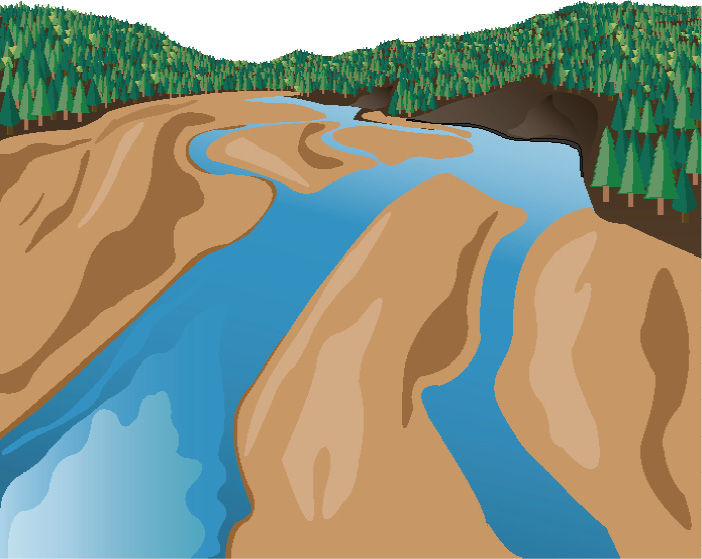The Elwha River is flourishing and showing a greater abundance of life since the removal of two dams five years ago. In this case, dam removal demonstrates that environmental benefits far outweigh economic costs and possible loss of jobs. Only time will tell how we can harness the earth’s natural forces in more efficient ways.
Washington took a big step towards clean energy five years ago when the phased removal of two dams on the Elwha River began. Now, with the project complete and the river unobstructed, the life-giving waters can finally restore the ecosystem to its former glory.
The Elwha River, famous for its historic salmon runs, flows across the Olympic Peninsula for 45 miles before emptying into the Strait of Juan de Fuca. More than a century ago, two dams were built to harness the energy of this powerful river. The Elwha Dam—the smaller of the two—was built in 1910 to supply energy to power a pulp mill. A growing economy and greater demand for industry led to the construction of the Glines Canyon Dam eight miles upstream. The failure to build fish ladders restricted available habitat for returning anadromous fish to a mere five miles. The dams also dealt a heavy blow to the Lower Elwha Klallam Tribe to which the river was a sacred source of food and tradition.
“This river is an important thread in a complex mountain watershed ecosystem,” said Maddie Piper, a freshman humanities for teaching major. “With this return of fish, these communities can return to their way of life. This is a time of healing.”
In 2011, the removal of both dams—two of the biggest dams in U.S. history—began after years of discussion among politicians, activists and researchers from across the country. Now that the dams are gone, many scientists are taking the opportunity to observe an ecosystem in the process of healing itself.
According to the National Park Service website, over 130 species in the Olympic National Park depend on salmon. Whether they’re eaten by eagles or bears, or their remains help the soil that nourishes plants grazed on by insects and other herbivores, the salmon are a crucial part of the ecosystem. Their return will be felt from the headwaters of the river deep in the Olympic Mountains to where it empties into the strait.
A restoration project is underway, with park botanists and dedicated volunteers leading to reseed the lake bed and encourage spawning habitat, according to the same site. Trees play a big role in moderating river temperatures and providing cover for vulnerable young salmon. The Elwha Corridor Restoration Plan calls for revegetation of the old lake beds to eradicate invasive species, stabilize the ecosystem, and reestablish the native forest.
“It’s a wonderful lesson in perseverance,” said Josephine Archibald, a professor for Civil and Environmental Engineering at Seattle U. “The first few years after a dam removal are the most vulnerable for these populations. The system will find equilibrium and get back to a natural flow.”
People like Archibald, along with Wesley Lauer, professor of Civil and Environmental Engineering, have taken several trips to the Elwha River to do research and make observations. They have worked together on several occasions to document the movement of sediment and study its impact on the path of the river.
Both dams were removed in “notches,” which means that the structure was removed one piece at a time. As the hole grew larger, sediment that had been accumulating for the last century made its way down the river.
The shoreline transformed after more than 34 million cubic yards of sediment was released from behind the dam and made its way downstream. Sandy beaches full of habitat for shellfish beds are reappearing, making researchers hopeful that bigger predators like seals, sea lions and octopi will return.
“It’s the largest case where a pulse of sediment has been released into a river of this scale and documented well,” Lauer said.
Senior physics major Jane Walden is working on her senior capstone project with Lauer and a graduate student from University of British Columbia. Together they are studying sediment transport in the Elwha hoping to better understand river dynamics, not just over years but over decades, even centuries, so they can make predictions that take long-term natural effects like climate change into account.
The removal of these dams also provided a unique opportunity for scientists like Lauer and Walden to study the geomorphology of rivers. It also sent a ripple through the world of clean energy, pointing the spotlight on dams across the country. As the planet suffers the damaging effects of fossil fuels, environmentalists are looking for new sources of clean energy.
“A lot of the dams in the U.S. are reaching their lifespan right now,” Walden said. “People are trying to figure whether to tear out these dams or repair them.”
The O’Shaughnessy Dam in the glacial Hetch Hetchy Valley in Yosemite National Park, Calif., is considered one of the first instances of environmental activism. Built in 1923 on the Tuolumne River, the dam flooded the entire valley and delivered water 167 miles west to San Francisco and other clients in the greater Bay Area. A movement born from the construction of this controversial dam, “Restore Hetch Hetchy,” active to this day, aims to restore the valley to its natural splendor.
According to Gordon Miller, an environmental studies professor in the College of Arts and Sciences, the “Age of Dam Removal” began in 1999 with the removal of Edward’s Dam, Maine, which was the first hydroelectric dam the government ever removed against the wishes of the dam owner. Since then nearly 1000 dams have been removed.
Washington State contains more than 800 hydroelectric dams. Some are used for flood and flow control, others are used to produce electricity and send it to the grid.
Dams didn’t have the negative connotation like they do today, Miller said. They used to be thought of as “democratic” because they provided water and energy for people living in small communities. Things are different now.
“The ecological impact, over the decades, started showing up more and more,” Miller said. “The Elwha will be an incredible laboratory over the next 20, 30 years to see what happens when you open up the river, let the salmon come back, and hopefully see how it revitalizes the ecosystem.”
The Elwha River is still getting used to its newfound freedom. After more than a century under confinement, scientists say the river will need a long time to heal. It’s a rare opportunity to watch a river be reborn and scientists will be watching closely to understand the evolution of rivers. Restoration projects like this will demonstrate the resilience of ecosystems and illustrate the benefits of dam removal.
But hydropower remains the cheapest way to generate electricity. Once the dam is built and the equipment installed, the river will do the rest. Flowing water is free and readily available. Furthermore, aquatic reservoirs like the one that used to exist between the dams on the Elwha River are good for recreational activities like swimming and boating.
According to National Geographic, hydroelectric power provides almost one-fifth of the world’s electricity. In 2004, the United States was among the top five largest producers of hydropower. Hydroelectric dams, while they do negatively impact the local ecosystem, still provide much needed power to millions of households across the country. In Washington, more than 70 percent of the electricity is produced by hydroelectric facilities. The biggest plant in the country is the Grand Coulee Dam on the Columbia River in northern Washington.
“Humans have to survive,” said Diana Jacobsmeyer, marine and conservation biology major. “We all have human rights to power and water, but look at how that impacts the environment.”
Leaving behind harmful energy sources means abandoning an infrastructure that is heavily dependent on harmful energy sources. To do this, many people will lose their jobs and billions will be spent on tearing down dams and other harmful structures. Environmentalists believe it’s the only path to a sustainable future.
Science will uncover new ways to harness the forces of our planet without causing harm to living things. Water, wind, and sun energy are constantly becoming more efficient and affordable. This case with the Elwha River demonstrates that the environmental benefits outweigh the economic costs, and that mother nature can recover if we give it a chance.
Nick can be reached at [email protected]














alex
Feb 26, 2016 at 4:36 pm
Fantastic!!! 🙂